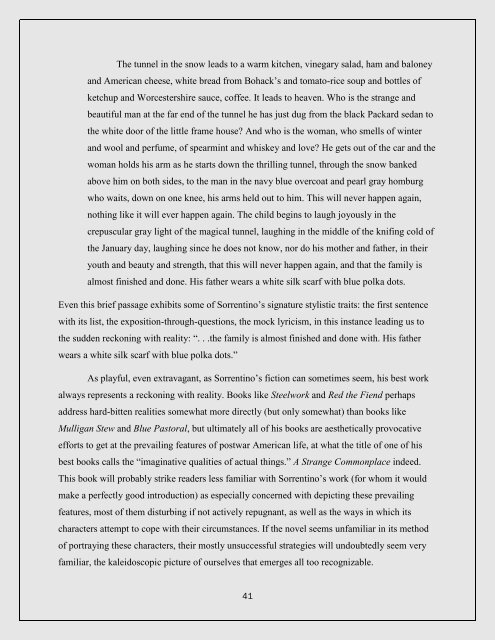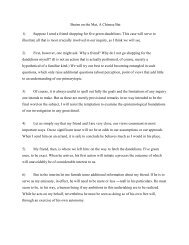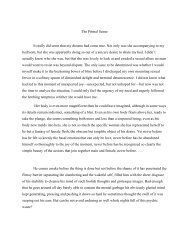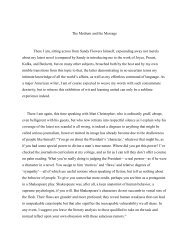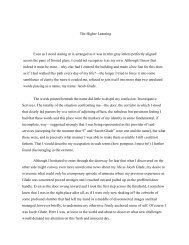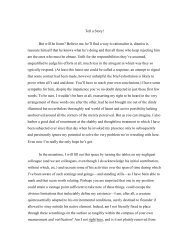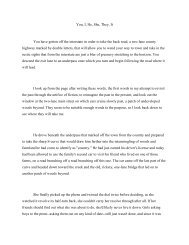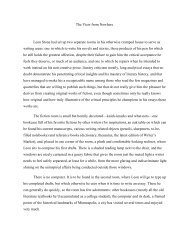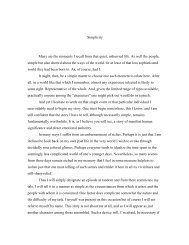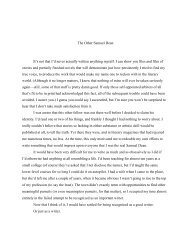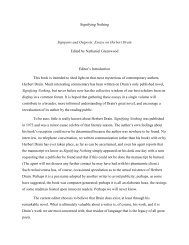APF
Create successful ePaper yourself
Turn your PDF publications into a flip-book with our unique Google optimized e-Paper software.
The tunnel in the snow leads to a warm kitchen, vinegary salad, ham and baloney<br />
and American cheese, white bread from Bohack’s and tomato-rice soup and bottles of<br />
ketchup and Worcestershire sauce, coffee. It leads to heaven. Who is the strange and<br />
beautiful man at the far end of the tunnel he has just dug from the black Packard sedan to<br />
the white door of the little frame house? And who is the woman, who smells of winter<br />
and wool and perfume, of spearmint and whiskey and love? He gets out of the car and the<br />
woman holds his arm as he starts down the thrilling tunnel, through the snow banked<br />
above him on both sides, to the man in the navy blue overcoat and pearl gray homburg<br />
who waits, down on one knee, his arms held out to him. This will never happen again,<br />
nothing like it will ever happen again. The child begins to laugh joyously in the<br />
crepuscular gray light of the magical tunnel, laughing in the middle of the knifing cold of<br />
the January day, laughing since he does not know, nor do his mother and father, in their<br />
youth and beauty and strength, that this will never happen again, and that the family is<br />
almost finished and done. His father wears a white silk scarf with blue polka dots.<br />
Even this brief passage exhibits some of Sorrentino’s signature stylistic traits: the first sentence<br />
with its list, the exposition-through-questions, the mock lyricism, in this instance leading us to<br />
the sudden reckoning with reality: “. . .the family is almost finished and done with. His father<br />
wears a white silk scarf with blue polka dots.”<br />
As playful, even extravagant, as Sorrentino’s fiction can sometimes seem, his best work<br />
always represents a reckoning with reality. Books like Steelwork and Red the Fiend perhaps<br />
address hard-bitten realities somewhat more directly (but only somewhat) than books like<br />
Mulligan Stew and Blue Pastoral, but ultimately all of his books are aesthetically provocative<br />
efforts to get at the prevailing features of postwar American life, at what the title of one of his<br />
best books calls the “imaginative qualities of actual things.” A Strange Commonplace indeed.<br />
This book will probably strike readers less familiar with Sorrentino’s work (for whom it would<br />
make a perfectly good introduction) as especially concerned with depicting these prevailing<br />
features, most of them disturbing if not actively repugnant, as well as the ways in which its<br />
characters attempt to cope with their circumstances. If the novel seems unfamiliar in its method<br />
of portraying these characters, their mostly unsuccessful strategies will undoubtedly seem very<br />
familiar, the kaleidoscopic picture of ourselves that emerges all too recognizable.<br />
41


